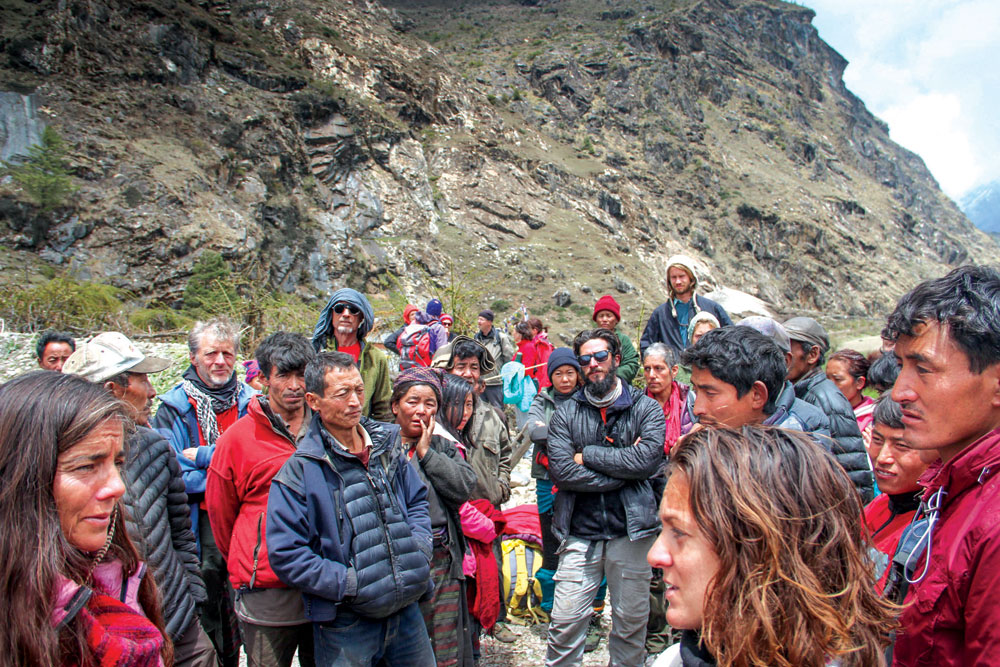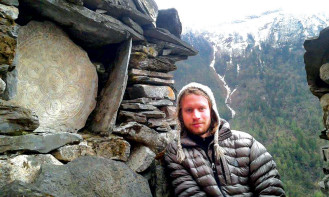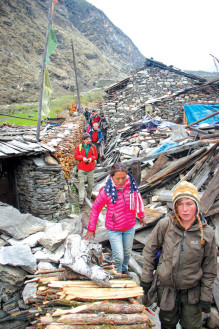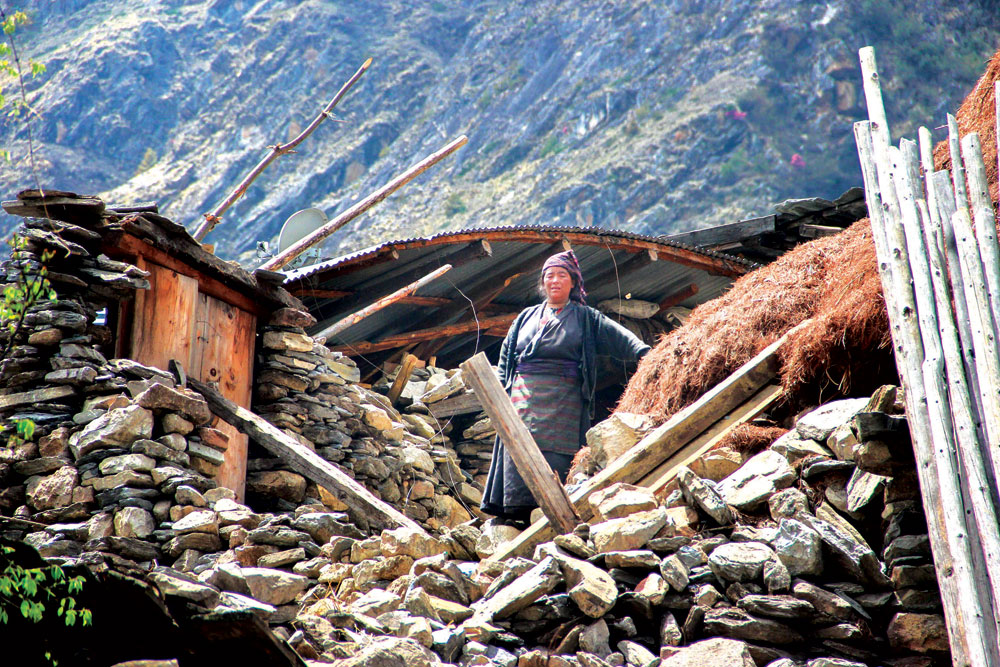
The group of 35 people trekking the Tsum Valley congregrate to discuss the damage and what they can do to help. Clay Burns stands at back in the white hat. Photos courtesy of Sacred Dance Nepal.

In the days before the earthquake hit, the group explored the valley. Here Clay Burns leans on a beyul, or prayer wall.
The ground began to shake and nearby houses made of stone slabs rattled as if about to collapse. Boulders crashed down the side of immense peaks, taking helpless yaks with them.
This is how Clay Burns remembers the moment the 7.8-magnitude earthquake hit on April 25 in the Tsum Valley, Nepal. This, and another powerful quake on May 12, killed nearly 8,700 people and injured 16,800 across the country, according to the Associated Press.
Burns, a Park Hill resident, had been trekking the valley with other tourists when the earthquake hit. Landslides triggered by the quake blocked the route to leave the valley and they were trapped for eight days. They survived and are now determined to help the Tsumba people who need food, medicine and tents, especially as monsoon season approaches.

After the earthquake, the group of international travelers assessed the damage in flattened villages.
These remote areas are low priority for relief efforts. Most of the resources go to areas with higher populations like the capital Kathmandu. “In a way it was good we were trekking at the time because they wouldn’t have anyone else to help them,” Burns says.
Until 2008, the valley was not open to outside people, according to the Tsum Welfare Committee, a not-for-profit dedicated to preserving its history. Tsum Valley is sanctioned as a sacred place in the Buddhist religion and known for meditation and monasteries. Four thousand people live in the valley. They survive on buckwheat, potatoes, rice and lentils. Abutted by the Ganesh Himalayas and inaccessible by road, it is uniquely remote and the high altitude brings many challenges.
Burns decided to trek the valley when he met a massage teacher who was organizing a trip to do volunteer massage work on the Tsumba people. As a professional massage therapist and eternal wanderer, he loved the idea.
Burns has studied massage techniques all around the world. For a couple of months at a time, he will live in Park Hill with his parents but inevitably his nomadic spirit whisks him away only to return a month or a year later. Ironically, almost exactly a year ago, he was traveling in Chile when the 8.2-magnitude earthquake struck off the coast and triggered tsunamis.

A Tsumba woman stands on the remains of her house.

Only the frame of a house is left after the earthquake.
The group trekking the valley included 18 people from the U.S., France, Germany, Australia, Austria, Argentina and Vietnam. The plan was to trek the Tsum Valley for a whole month: 10 days to get to the valley, 10 days in the valley, and 10 days to trek out. They began on April 7.
They were able to spend 10 days in the valley before the earthquake hit. It was hard to tell how bad the damage was until they reached a village. “The village below was totally flattened. That’s when we started to understand how serious this was,” Burns says. That’s also when they discovered they were trapped.
Other international travelers who had been trekking various parts of the valley and were trapped as well joined their group, now totaling 35 people. A Tsumba named Dhawa Gyanjen Lama, who had been guiding a French couple through the valley, opened up his guesthouse and fed all the travelers.
“They barely have anything and they were still taking care of us,” Burns says. No one in the group was able to get cell service until two days after the earthquake. At that point, the tourists had been reported missing in their home countries. The U.S. embassy tracked the cell phone number of one of the tourists and was able to get in contact with the group to assure they were sending evacuation helicopters in a few days.
In the meantime, they tried to help the Tsumba people but there wasn’t much they could do. They needed supplies and it was too dangerous to attempt rebuilding homes that were on the verge of collapse. At one point, a lama arrived and gave each Tsumba $100, but money really had no value with no way to get to Kathmandu to buy supplies.
“We were concerned because we were such a large group that we were using up their resources. We were trying to figure out if the embassy was sending helicopters, then maybe they could also send supplies to the Nepalese people,” Burns says.
A couple of days later, helicopters began to arrive. Every helicopter looked the same and it was unclear who was supposed to go where. Anxious travelers chaotically jumped in. Burns struggled to understand this scene— tourists scrambling to get out of the valley as fast as possible but leaving behind the Tsumba people with nothing.
Home again, Burns has vigorously been raising money and sending it to Dhawa, whose wife works for a helicopter company and has been able to send supplies.
Perhaps it was the dramatic landscape that seemed more heaven than Earth, or the valley’s sacred history, but throughout it all Burns felt a mystical element that protected them. “To get from trauma to gratitude I’ve really had to simplify everything now. Move more slowly. Eat more slowly. Focus on what’s in front of me. Be more present. Otherwise it’s just too overwhelming.” To learn more about the Tsum Valley and relief efforts, visit www.youtube.com/watch?v=QqGGsESWxnw. Clay Burns can be reached at email clayaburns1@gmail.com.

The Tsumba people receive bags of rice funded by the international travelers after leaving the Tsum Valley.




0 Comments